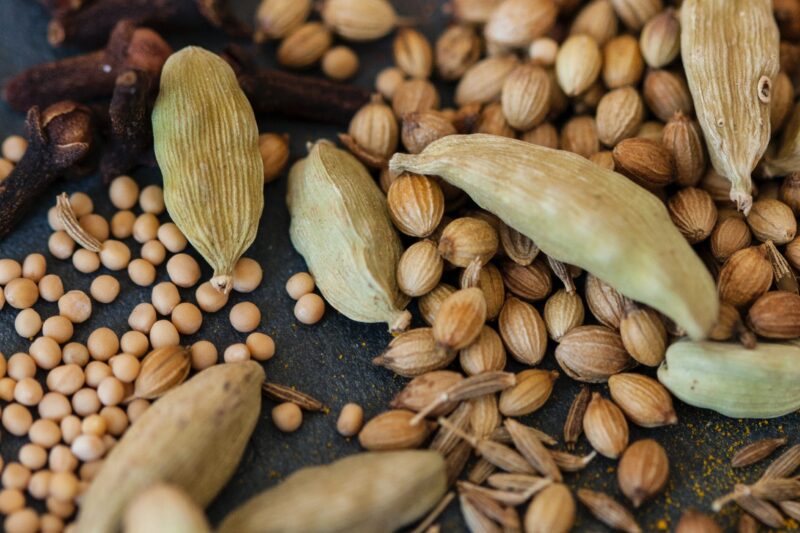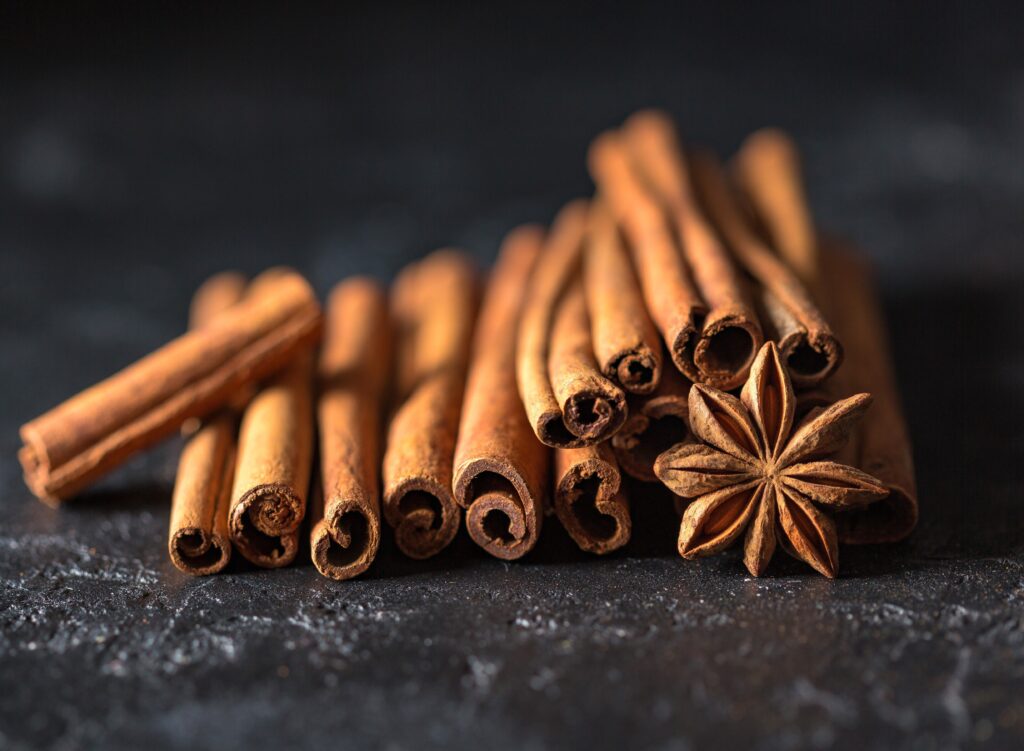
It’s here! Winter has arrived in Melbourne and the tights, boots and big jumpers are out… a great disguise for all that banana bread we’ve been baking..and eating. The frosty mornings, sneaky sunshine, heavy rains and cosy evenings by the fire are a welcome relief after fires,drought and pandemic. It’s OK to be quieter now and heal a little from an insane year, as we emerge from the ” Unprecedented.” This week Julia Richards, our dear friend has sent through an article about ways to use spices for healing and wellness. What, there’s more than mulled wine? Apparently yes…..it’s a terrific article with some lovely recipes too. Thank you Julia…enjoy your glorious spring in Yorkshire.
The healing benefits of warming spices
I love cooking and as a medical herbalist I regularly use food as medicine. Using heat producing spices such as ginger, cardamom, cinnamon, cayenne and turmeric during autumn and winter helps to keep our body functioning optimally. They also pair beautifully with seasonal foods such as root vegetables. Before I share some of my own healthy recipes with these delicious ingredients, let’s look at why including these spices into your diet at this time of year can be incredibly beneficial.
In general, warming spices increase circulation, bringing blood to the surface of the skin. This, along with removing excess water from tissues helps to raise our body temperature and keep us warm. They also help digestion thereby improving our energy which can become sluggish in these cooler seasons. Ayurvedic medicine believes that our digestion must work harder in the cooler half of the year to fuel our digestive fire. In Chinese medicine, yang foods, which includes these spices, are used to warm and activate our energy. Western herbal medicine and scientific evidence report similarly on the benefits.
Ginger
Gingerols are one of the main active components in fresh ginger and make it an anti-nausea and anti-inflammatory food. Gingerols increase digestive responsiveness to empty the stomach and support the release of blood-pressure regulating hormones to calm the body and reduce nausea. Ginger can, therefore, reduce motion sickness, pregnancy morning sickness and nausea and vomiting brought on by medications including chemotherapy. Gingerols also act as a COX-2 inhibitor like common medications used for rheumatoid arthritis and psoriatic arthritis to reduce pain and inflammation. Osteoarthritis can also benefit from it. In addition, they block inflammatory prostaglandins (these dilate intra and extra cranial arteries causing headache) therefore reduce migraine pain.
Use fresh and powdered ginger cooked into curries, stir fries and soups. Try fresh grated ginger in smoothies and salad dressings. Make a tea with some slices of fresh ginger and lemon – its lovely with added mint leaves and honey. You can also have a ginger bath to relax muscles and relieve cold / flu symptoms. Simmer 200g of fresh ginger in 2L of water for about 20 mins. Strain and add to your bath water. Add some essential oils such as rosemary, tea tree, eucalyptus or oregano for extra benefit.
Cardamon
The phytochemicals in cardamom give it many actions. As an expectorant, it helps open respiratory passages therefore easing asthma symptoms. As an antioxidant it can help prevent inflammation in the body. Both of these actions provide protection against digestive issues including stomach ulcers. It enhances the natural killer cells and may therefore help prevent tumours. Being an anti-inflammatory and diuretic, it can lower blood pressure. As an anti-bacterial it is often used to treat bad breath and help prevent cavities. Indian restaurants offer it to chew on after a meal to act as a digestive and freshen breath and it’s often used in chewing gum for the same reasons.
Use the crushed seeds in curries and soups. You’ll also find it used in Scandinavian baking recipes. It combines nicely with chocolate, coffee and chai drinks.

Cinnamon
Cinnamon is a circulatory stimulant and effective for warming cold hands and feet. Other actions include: supporting metabolic function and sugar imbalances by decreasing glucose and insulin levels therefore beneficial for those with DiabetesType 2 at a dose of 0.5-2 teaspoons per day; reducing bad LDL cholesterol; as a digestive for indigestion, flatulence, bloating and cramps; stimulating appetite that has been reduced due to illness.; antimicrobial and anti-fungal properties due to cinnamaldehyde which can heal teeth and gum issues and reduce infection in diahorrea; drying and clearing mucous secretions; possibly inhibiting the build up of tau protein the brain which is an indicator of Alzheimer’s; and possibly helping protect neurons, normalise neurotransmitter levels and improve function in Parkinson’s disease.
Use cinnamon in sweet and savoury dishes, smoothies and hot drinks. A sprinkle in a meat or veggie chilli gives a great depth of flavour. You can also make a tooth powder with it. Just dip a wet tooth brush into a small dish of powdered cinnamon and then gently brush teeth and gums.
Cayenne
The active constituent capsaicin acts as a circulatory stimulant and anti-inflammatory. These actions are useful for: increasing circulation to cold hands and feet; promoting mucus secretion to clear chest and sinus infections; and stimulating digestion. Recent studies have shown that it can have a protective effective on the stomach lining and may prevent peptic ulcers; and that it relieves pain by blocking substance P, a pain transmitter in the nerves.
Use topically for arthritis, back pain, sciatica, shingles pain and headaches. Infuse into a sterilized lidded glass jar or bottle, 1 part cayenne powder to 4 parts oil such as olive or nut oil. Leave in a cool, dark place and shake daily for about 10 days. Massage into the pain area. You can also sprinkling a bit of cayenne between your shoes and socks to help warm the feet when outdoors Note: Do a patch test first to ensure your skin doesn’t react negatively. As a food, powdered cayenne adds a little kick to savoury and sweet dishes. It combines nicely with chocolate.
Note: If on Warfarin or blood thinning medication, check with your doctor before adding cayenne to your diet.
Turmeric
Recently, turmeric has been touted as a wonder spice, good for everything. Curcumin is the main active chemical which inhibits mediators of the inflammatory response. Using turmeric, especially when combined the black pepper is beneficial for easing rheumatism, arthritis, inflammatory skin and bowel conditions and asthma. Curcumins also lowers cholesterol, thins blood and as a bitter stimulates the digestive process. It has also been shown to help manage metabolic syndrome. It may also help in reducing exercise induced inflammation and muscle soreness to increase recovery in active people. Used topically it can help fade scars, lighten pigmentation and reduce spots.
If wanting to use it topically, I recommend buying a prepared oil as making your own can get messy and stain things. Internally, use the powder or fresh root in curries, sauces, soups , smoothies and golden milk.
My warming recipes
Here are a few of my favourite ways of using these warming spices during autumn and winter.
Julia’s Golden Soup
Ingredients
1 large onion roughly diced
1 thumb sized piece of fresh ginger diced
3 large carrots in large dices
1 sweet potato in large dices
1 butternut squash in large dices
½ cup dried red lentils
6 cardamon pods split with seeds removed
1 teaspoon turmeric
1 teaspoon coriander
½ teaspoon cumin
Handful of fresh coriander chopped
Black pepper and salt to taste
2 tablespoons coconut oil
2L of vegetable stock
Handful of toasted and chopped nuts such cashews or hazel nuts.
Method
Heat oil on a low temperature until melted
Add onion and sauté until translucent
Add ginger and sauté for another minute
Add the rest of the chopped vegetables and sauté for a few minutes
Add the spices and mix around
Add the lentils and mix in with everything
Add the stock. Bring to a boil and then simmer with lid half on for 45 mins or until vegetables are very tender.
Add the fresh coriander and whiz with a handheld blender or in a food processor.
Serve with a dollop of yoghurt or coconut cream and sprinkle over some fresh chopped coriander and toasted chopped nuts
Julia’s Moroccan Vegetable Tagine
Ingredients
2 tablespoons vegetable oil
2 large onions sliced
4 cloves of garlic sliced
1 red chilli finely diced
1 thumb sized piece of fresh ginger finely diced
1 tablespoon each of cumin, coriander, turmeric, paprika, allspice
¼ teaspoon dried ginger, cayenne, cinnamon, nutmeg, fenugreek seeds, cardamom seeds
¼ cup each of chopped fresh coriander and parsley
2 tablespoons sundried tomato paste
2 large tomatoes in large dices
1 large carrot, sweet potato and potato in large dices
¼ butternut squash in large dices
½ red capsicum and fennel in large dices
1 zucchini in large dices
½ cup chopped green beans
1L boiled water
1 can of drained chickpeas
Method
Heat oil on a low temperature
Add onion and capsicum and sauté until onion is translucent
Add fresh ginger, garlic and chilli and sauté for another 3 minutes
Add the tomato paste and all the spices. Mix through.
Add the boiled water. Cover and simmer for 20 mins.
Add the carrots, sweet potato, potato, butternut squash, and fennel and simmer until half cooked
Add the tomatoes, zucchini, green beans, fresh coriander and parsley and chickpeas
Simmer until all vegetables are tender
Taste and season if required.
Serve on a bed of steaming quinoa, couscous or rice and sprinkle with more fresh chopped coriander and parsley
Julia’s spiced mocha
Ingredients
3 teaspoons of good quality dark drinking chocolate powder or grate the equivalent from a piece of 70% dark chocolate
¼ teaspoon of cinnamon
Pinch of nutmeg
Pinch of ground star anise
1 cup of your favourite coffee
1/3 cup coconut milk (or milk of your choice)for frothing
Note: if you like it sweet, add a dash of vanilla syrup. If you like it spicy, add a pinch of cayenne powder.
Method
Place the chocolate and spices in your coffee cup
Pour in your coffee and stir well
Top with frothed coconut milk and sprinkle with chocolate and cinnamon
Note: if you don’t have a milk frother then you can heat the milk and froth with a hand whisk/blender or put in a sealed jar and shake vigorously.
Enjoy and experiment with making up your own recipes or trying new ones from a cook book or internet search. We’d love you to share your favourite in the comments.
Always seek a qualified Medical Herbalist before using herbs to treat any condition. Always check how the herb interacts with any medication you are taking.

